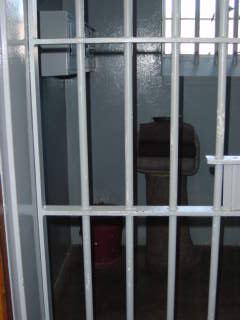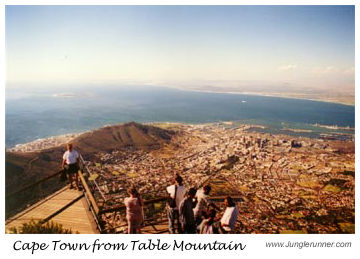
Nelson Mandela's cell on Robben Island in Cape Town, South
Africa. |
#1 - Robben Island
Sally DeFina - 5 July
2001
(Cape Town, SOUTH AFRICA) - Our guide was
speaking at almost a whisper � so softly that I had to physically
move to within 3 feet of him in order to hear. His eyes were
lowered to the ground as he shyly told us about the tour of
the prisons at Robben Island in Cape Town where he had been
held for four years for the �crime� of belonging to the ANC.
He was �lucky�, he said. Other prisoners spent decades at Robben
Island, the prison used for black political prisoners during
the Apartheid era in South Africa. Nelson Mandela spent 18 of
his 27 years behind bars at Robben Island, along with many other
leaders of the struggle against Apartheid.
Our guide, Muth, asked us in a soft, dignified
voice that if we had any questions at all, to please not be
shy. �Were the political prisoners kept alongside criminals?�
came a question from an American gentleman at my back. Muth�s
eyes opened a little and his voice rose a notch as he started
explaining that in South Africa, the prisoners of Apartheid
were all considered to have committed crimes against the government
and therefore were not considered political prisoners. His voice
still rising with emotion, he related how at first all the political
prisoners were kept with hardened criminals as a way to break
political prisoner�s spirits. In the mid-1970�s, however, the
political prisoners were separated from the other criminals
when it was determined that their ideas were �infecting� the
prison. By the end of his speech about criminals, Muth was speaking
quite loudly and was boldly looking directly into my eyes �
and I saw the internal turmoil and fire that undoubtedly landed
Muth at Robben Island in the fi rst place.
As we made our way around the prison, Muth
stopped occasionally to shake his head sadly at something that
he remembered from his days inside. In the dining area, he stopped
and shared his thoughts with us: �we received bread and hot
soup in the summer, and bread and cold drink in the winter -
and it was unbelievably cold here in the winter, and unbelievably
hot in the summer. They were trying to break our spirits. They
could never have done it�, he said in an incredulous voice.
�What did you do to land here?� I asked
Muth after we were alone outside the prison. �A terrible, terrible
thing� he said gravely as he shook his head and looked at me
with intense seriousness. �I belonged to the ANC� he said and
smiled sheepishly. �A terrible crime.�
 I read up on Apartheid over the next few days as we drove along
the Garden Route, and was so appalled at treatment that black
South Africans were forced to endure throughout history, that
I was emotionally compelled to write about it. Although African
blacks have been mistreated and enslaved since first coming
into contact with Europeans, it was South Africa alone that
attempted to continue this abuse into the 21st century by passing
Apartheid laws in 1948 - Apartheid literally meaning the state
of being apart. These laws included a law prohibiting interracial
marriage and sex, a law requiring individuals to be characterized
by race, and a law ensuring the physical separation of blacks
in residential areas and public areas.
I read up on Apartheid over the next few days as we drove along
the Garden Route, and was so appalled at treatment that black
South Africans were forced to endure throughout history, that
I was emotionally compelled to write about it. Although African
blacks have been mistreated and enslaved since first coming
into contact with Europeans, it was South Africa alone that
attempted to continue this abuse into the 21st century by passing
Apartheid laws in 1948 - Apartheid literally meaning the state
of being apart. These laws included a law prohibiting interracial
marriage and sex, a law requiring individuals to be characterized
by race, and a law ensuring the physical separation of blacks
in residential areas and public areas.
The most hated laws put into place were
the Pass laws which forced blacks to carry identity cards at
all times and prohibited blacks from visiting towns unless specific
permission was granted. These laws ensured that blacks, about
70% of the population, remained in separate areas that made
up only 7.5% of the land. Blacks were no longer free to roam
about their own country and were arrested if found without their
cards. Muth had joked with us that during Apartheid, if a black
man was seen running into a burning building, it was to save
his identity card and not for the women and children.
The struggle against these discriminatory
laws continued from the moment they were passed until they were
repealed in 1991. In the process, hundreds of people were killed
or wounded in demonstrations and protest marches, and thousands
arrested and tortured. In the years from 1985 (when the government
declared a state of emergency) to 1988, it is estimated that
approximately 30,000 people were detained without trial Other
countries, disgusted at the South African government�s blatant
disregard for human rights, increased economic sanctions until
the point that the South African Rand finally collapsed. By
1991, all discriminatory laws were finally repealed and all
political prisoners finally released.
During free elections in 1994, the Apartheid
era was finally declared over when Nelson Mandela was elected
as president. Only 7 years after the official end of Apartheid,
the effects are still quite visible to visitors, the most noticeable
being the almost complete lack of blacks in many tourist areas
of the country (including the Waterfront area of Cape Town and
The Garden Route). Given the brutality of the Apartheid government,
I suppose that the un-separation of races will take a couple
of generations at least. In the meantime, South Africa is not
hiding from its past, but rather openly encouraging debate about
it. The opening of Robben Island to the public was one of the
ways of accomplishing this. As Muth explained to us at the end
of our tour, former prisoners have returned to Robben Island
for exactly the same reason: �to keep the history of the prison
and its criminal past alive for reconciliation, not for the
sake of revenge�.
|

